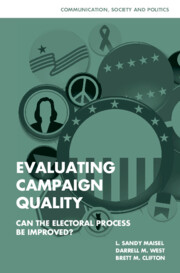4 - Impact on Campaign Discourse
Published online by Cambridge University Press: 03 December 2009
Summary
In recent years, there has been considerable concern about the tone, style, and content of political campaigns. In many races, by the time of voting, “ad fatigue” grips the voters. The arrival of Election Day is not seen as a time to celebrate democracy but rather as a period to be thankful that campaign ads no longer litter the airways. There is a more fundamental sense in which Election Day is not seen as the fruition of the nation's democratic electoral process. As Figure 4-1 reveals, turnout in presidential elections has hovered around 50 percent for the last eight elections; turnout in congressional elections, especially those held in nonpresidential years has been considerably lower.
Political reformers feel that citizen discontent is the result, in part at least, of the content of electoral campaigns. To be sure, voters are bombarded with campaign messages of all types, with television and radio ads, with direct mail, with telephone messages, with literature on the doorstep, with speeches, Web sites, and more. These messages and the campaigns are covered on television and in the newspapers. Candidates debate each other in front of a variety of audiences, most often in person but on important occasions before media audiences. But the relevant question is whether the delivered messages are those the voters need to receive.
- Type
- Chapter
- Information
- Evaluating Campaign QualityCan the Electoral Process be Improved?, pp. 46 - 78Publisher: Cambridge University PressPrint publication year: 2007



